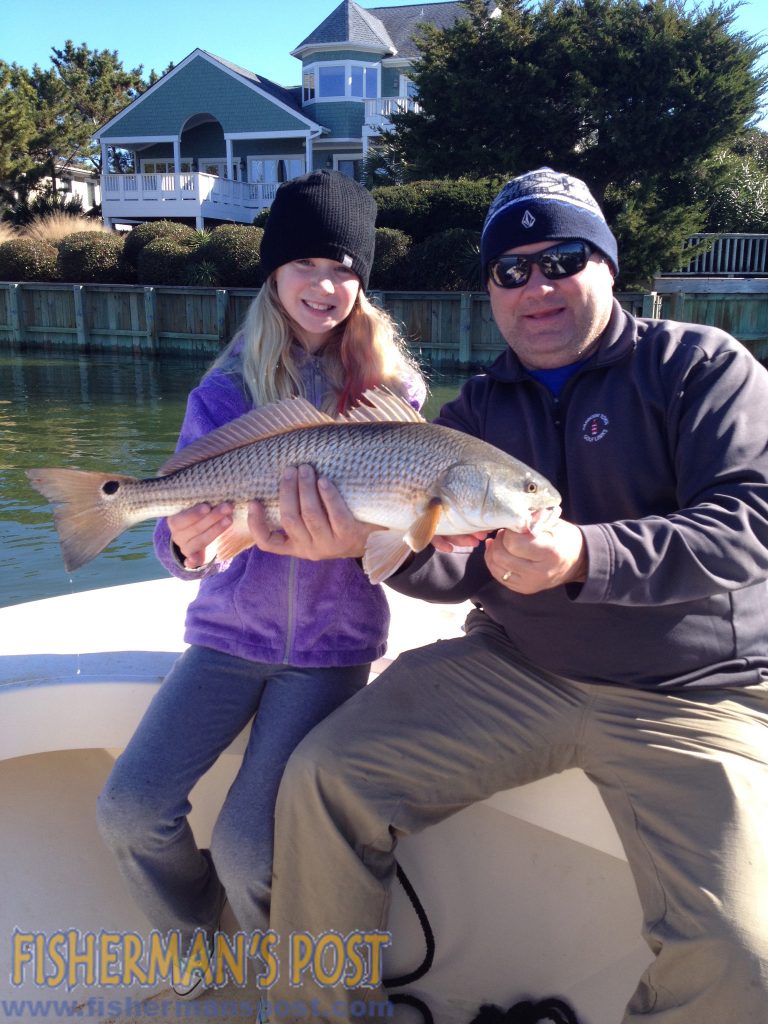Wrightsville Beach – March 5, 2015
Arlen, of Tex’s Tackle, reports that anglers are still finding a few fish to keep them occupied despite the cool weather, and better fishing and warmer temperatures are on the horizon.

Kate and Philip Maginnes with a slot red drum Kate caught and released under a Wrightsville Beach dock after it bit a peeled shrimp on a Carolina rig.
Cape Fear River striped bass have been helping many anglers stave off the winter blues, and those targeting the fish are picking up decent numbers, though the bite can be highly hit-or-miss.
Trolling diving plugs along drop-offs and channel edges in the river is accounting for many of the fish that anglers are hooking. Casting soft plastics and other lures to shoreline structure and along the same ledges is also producing action (and often leads to larger fish).
A few red and black drum are still looking for meals under area docks along the ICW, creeks, and boat basins. Cut shrimp fished on bottom rigs or jigheads will fool both fish, and anglers can also often tempt the reds to bite Gulp baits crawled slowly along the bottom.
Some red drum are also feeding in the surf zone along the beachfronts and inlet shoals from Topsail to Cape Fear. Anglers can target the surf reds by casting from the beachfront or running boats along the backsides of the breakers on calm days to look for schools huddled up in the clear water. Gulp baits, MirrOlures, casting spoons, and a variety of other lures will fool the reds in the surf and are often much more effective than bait in the cooler water.
Those making it out to reefs and wrecks in the 10-15 mile range should be able to find some action with legal sea bass and a few tautog. Both small vertical jigging lures and baited bottom rigs will get attention from the tasty reef dwellers.
Bottom fishing further offshore will produce larger sea bass and beeliners and triggerfish once anglers make it 40-50 miles out. Squid and cut baits are tough to beat for all the bottom dwellers.
Anglers making the run to the break can take advantage of the cold weather, as it tends to concentrate cobia, African pompano, and amberjacks along the high-relief ledges in the area. Vertical jigs worked around fish that anglers mark on their sounders will fool all three and plenty of other species holding in the same areas.
Wahoo and blackfin tuna are also looking for meals along the break and will pounce on trolled ballyhoo or artificial lures.
Rick, of Living Waters Guide Service, reports that anglers making the long run offshore can expect to encounter schooling blackfin tuna over the month of March. The fish will generally be holding around structure and bait concentrations in the area, where anglers can locate them while trolling ballyhoo and smaller artificial lures. Those who find large concentrations of the tuna can also work vertical jigs and often topwater poppers through and above the schools to hook up.
A few wahoo are feeding in the same areas, and anglers can target them with larger trolling lures and rigged ballyhoo pulled on wire leaders.
Vertical jigging around structure along the break is often highly productive this time of year, and anglers can expect to encounter African pompano, amberjacks, and possible cobia (along with plenty of bottom dwellers) while working jigs in 150-300’ of water at present.
Jim, of Plan 9 Charters, reports that anglers were seeing some solid action with red drum in the surf near local inlets before the past few weeks of wintry weather. Warming temperatures should put the fish back on the feed, and anglers can hook up with them while working soft plastics, spoons, and other artificials around fish they spot schooled up along shoals and sloughs.
The striped bass bite has been decent in the Cape Fear River, where anglers are hooking most of their fish while casting white soft plastic baits on jigheads and weedless hooks.
Some shad have begun to show up further up the Cape Fear, and anglers looking for some exciting early spring action can head up towards Lock and Dam #1 to connect with the acrobatic tusslers. Small spoons, flies, and soft plastics will attract plenty of attention from the shad.
Lynn, of Shearwater Charters, reports that anglers caught some scattered king mackerel around 40 miles out of Wrightsville early in the week. The king action should improve as warmer water pushes inshore over the spring. Anglers can tempt the kings to bite dead cigar minnows, strip baits, and spoons until live baits become more readily available later in the spring.
Anglers who can make the run to the Gulf Stream should see some solid blackfin tuna action at local spots like the Steeples and Same Ol’ Hole over the course of the month as well.
Ryan, of Johnnie Mercer’s Pier, reports that anglers have caught plenty of dogfish and skates over the winter while bottom fishing with cut baits and shrimp.
Some sea mullet and pufferfish should join in on the action when the water temperatures rise into the upper-50’s.
The water is currently 49 degrees.

